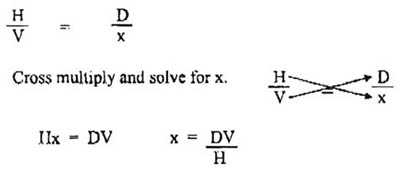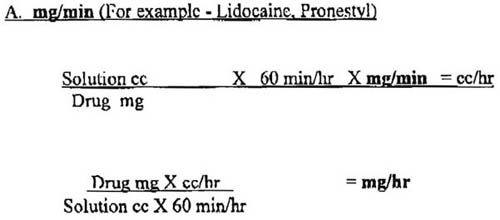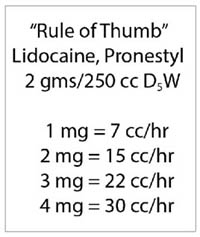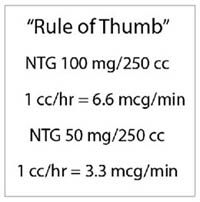


Many nurses are weak with drug calculations of all sorts. This article will help to review the major concepts related to drug calculations, help walk you through a few exercises, and provide a few exercises you can perform on your own to check your skills. There are many reference books available to review basic math skills, if you find that you have difficulty with even the basic conversion exercises.
Common Conversions:
1 Liter = 1000 Milliliters
1 Gram = 1000 Milligrams
1 Milligram = 1000 Micrograms
1 Kilogram = 2.2 pounds
Methods of Calculation
Any of the following three methods can be used to perform drug calculations. Please review all three methods and select the one that works for you. It is important to practice the method that you prefer to become proficient in calculating drug dosages.
Remember: Before doing the calculation, convert units of measurement to one system.
I. Basic Formula:Frequently used to calculate drug dosages.

D = dose ordered or desired dose
H = dose on container label or dose on hand
V = form and amount in which drug comes (tablet, capsule, liquid)
Example: Order-Dilantin 50mg p.o. TID Drug available-Dilantin 125 mg/5ml

II. Ratio & Proportion: Oldest method used in calculating dosage.

Left side are known quantities. Right side is desired dose and amount to give
Multiply the means and the extremes

Example: Order-Keflex 1 gm p.o. BID Drug available-Keflex 250 mg per capsule

III. Fractional Equation
H
V = D
X
Cross multiply and solve for X.

Example: Order - Digoxin 0.25 mg p.o. QD Drug Available - 0.125 mg per tablet

IV. Intravenous Flow Rate Calculation (two methods)
Two Step
Step 1 - Amount of fluid divided by hours to administer = ml/hr

One Step

Example: 1000 ml over 8 hrs IV set = 15 gtts/ml
Two Step
Step 1 - 1000 divided by8 = 125
Step 2 - 
One Step

IV. How to Calculate Continuous Infusions


B. mcg/min (For example - Nitroglycerin)



C. mcg/kg/min (For example - Dopamine, Dobutamine, Nipride, etc.)
1.) To calculate cc/hr (gtts/min)

Example: Dopamine 400 mg/250 cc D5W to start at 5 mcg/kg/min. Patient’s weight is 190 lbs.

2. To calculate mcg/kg/min

Example: Nipride 100mg/250 cc D 5 W was ordered to decrease your patient’s blood pressure. The patient's weight is 143 lbs, and the IV pump is set at 25 cc/hr. How many mcg/kg/min of Nipride is the patient receiving?

V. How to calculate mcg/kg/min if you know the rate of the infusion

For example:
400mg of Dopamine in 250 cc D 5 W = 1600 mcg/cc÷ 60 min/hr= 26.6 mcg/cc/min
26.6 is the dosage concentration for Dopamine in mcg/cc/min based on having 400mg in 250cc of IV fluid. You need this to calculate this dosage concentration first for all drug calculations. Once you do this step, you can do anything!
NOW DO THE REST!
(If you have a 75 kg patient for example...)
 =
3.5 mcg/kg/min (rounded down)
=
3.5 mcg/kg/min (rounded down)
B. How to calculate drips in cc per hour when you know the mcg/kg/min that is ordered or desired

For example:
400 mg Dopamine in 250 cc DW = 26.6 mcg/cc/min

ALWAYS WORK THE EQUATION BACKWARDS AGAIN TO DOUBLE CHECK YOUR MATH!


For example:
400mg of Dopamine in 250 cc DW = 1600 mcg/cc 60 min/hr = 26.6 mcg/cc/min
26.6 is the dosage concentration for Dopamine in mcg/cc/min based on having 400 mg in 250 cc of IV fluid. You need this to calculate this dosage concentration first for all drug calculations. Once you do this step, you can do anything!
NOW DO THE REST!!
(If you have a 75 kg patient for example)

Now do some practice exercises to check what you learned
A. Practice Problems:
B. Practice Problems: Use the method you have chosen to calculate the amount to give.
C. Practice Problems:
D. Practice Problems:
Summary
Many nurses have difficulty with drug calculations. Mostly because they don’t enjoy or understand math. Practicing drug calculations will help nurses develop stronger and more confident math skills. Many drugs require some type of calculation prior to administration. The drug calculations range in complexity from requiring a simple conversion calculation to a more complex calculation for drugs administered by mcg/kg/min. Regardless of the drug to be administered, careful and accurate calculations are important to help prevent medication errors. Many nurses become overwhelmed when performing the drug calculations, when they require multiple steps or involve life-threatening drugs. The main principle is to remain focused on what you are doing and try to not let outside distractions cause you to make a error in calculations. It is always a good idea to have another nurse double check your calculations. Sometimes nurses have difficulty calculating dosages on drugs that are potentially life threatening. This is often because they become focused on the actual drug and the possible consequences of an error in calculation. The best way to prevent this is to remember that the drug calculations are performed the same way regardless of what the drug is. For example, whether the infusion is a big bag of vitamins or a life threatening vasoactive cardiac drug, the calculation is done exactly the same way.
Many facilities use monitors to calculate the infusion rates, by plugging the numbers in the computer or monitor with a keypad and getting the exact infusion titration chart specifically for that patient. If you use this method for beginning your infusions and titrating the infusion rates, be very careful that you have entered the correct data to obtain the chart. Many errors take place because erroneous data is first entered and not identified. The nurses then titrate the drugs or administer the drugs based on an incorrect chart. A method to help prevent errors with this type of system is to have another nurse double check the data and the chart, or to do a hand calculation for comparison. The use of computers for drug calculations also causes nurses to get “rusty” in their abilities to perform drug calculations. It is suggested that the nurse perform the hand calculations from time to time, to maintain her/his math skills.
Reference: Dosage Calculations Made Incredibly Easy! by Springhouse Corporation, 1998
Louise Diehl, RN, MSN, ND, ACNS-BC, NP-C
Nurse Practitioner - Owner
Doctor of Naturopathy
Phone: 908-213-8808
Fax: 908-213-8898
Lehigh Valley Wellness Center
101 Coventry Drive
Phillipsburg, NJ 08865
E-mail: info@lehighvalleywellnesscenter.com


